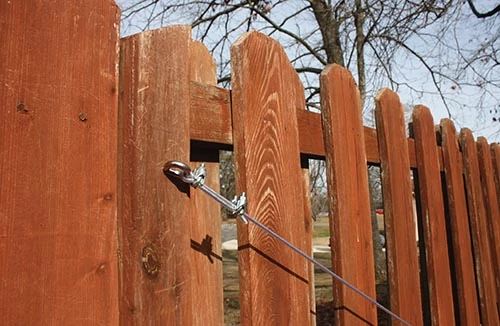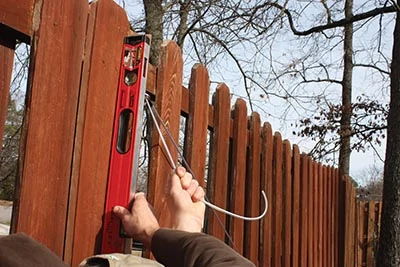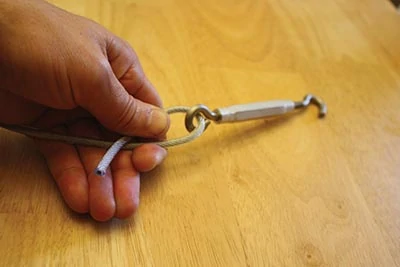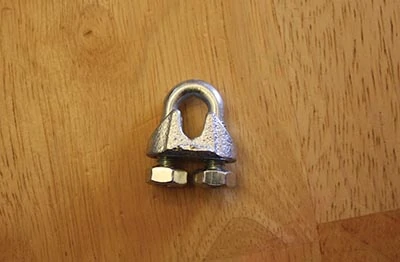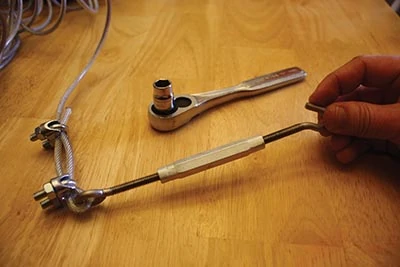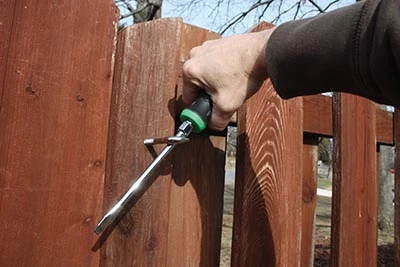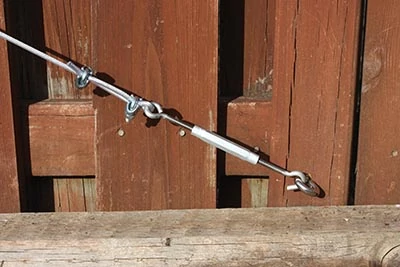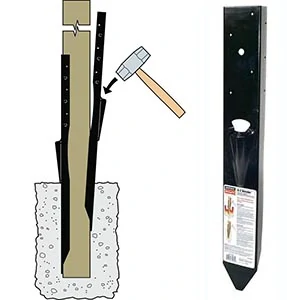Use a steel wire to stabilize a leaning post and prevent further damage to your fence.
A fence is only as strong as its posts. Once a post begins to lean, gravity pulls it along and the problem only worsens until it gets fixed. And the more a post leans, the more stress it puts on the surrounding rails and pickets, distorting the shape of the fence and causing structural damage.
The quick fix shown in this article will stabilize the fence post and prevent further damage until you have the opportunity to make a more permanent repair to the base of the post.
In our case, the ground on the outside of the problem post sloped downhill, so the post had more support on one side than the other. When a mid-winter thunderstorm generated some remarkably strong straight-line winds, the gales rocked the post back and forth and loosened it from the surrounding concrete and soil.
The day after the storm, the fence post was leaning dramatically toward the outer downhill slope, along with the surrounding fence boards.
To salvage a fence in a situation like this, you should address the problem post as soon as possible.
Step by Step
The winds of a thunderstorm left this fence post leaning drastically to one side, pulling all the fence boards along with it.
To use the steel-wire method, you’ll need wire clips, steel wire, a turnbuckle and a couple of lag-screw eyes. For outdoor use, choose stainless steel components and vinyl coated wire.
Loop the steel wire through the eye of the turnbuckle and turn it back about 4 inches.
Unscrew the two nuts from a wire clip to disassemble the clip. Clamp the doubled wire between the clip’s saddle and U-bolt.
Replace the nuts on the clips to secure the wire to the turnbuckle. Use two wire clips at each connection, and remember never to “saddle the dead horse.” (See Side Note 1)
Extend the turnbuckle’s eye and hook by unscrewing the threads.
Predrill a pilot hole for the lag screw eye at your mounting point. The mounting point must be stable and secure. I used the base of the next fence post as the mounting point, and screwed in an eye close to the ground. Mount the eyes on the opposite side of the post from the direction in which it is leaning.
Insert a second lag screw eye near the top of your leaning post. A screwdriver makes a good handle for screwing the eyes in place.
Hook the turnbuckle onto one of the eyes and run the steel wire from the end of the turnbuckle through the eye on the leaning post.
Pull the fence post into plumb position as you pull the slack out of the wire.
Secure the wire to the upper eye with a couple of wire nuts.
Tighten the threaded connection of the turnbuckle to apply tension to the wire and, in turn, the fence post. Tighten the turnbuckle until the post is as plumb as possible and no longer moves.
Here’s the completed repair. It’s not the most beautiful repair in the world but it’s effective, and will keep the fence in shape until we get time to dig out the post base and reinforce it with more concrete.
Side Note 1
Don’t Saddle a Dead Horse
I’ve learned that “don’t saddle a dead horse” is a common saying among tradespeople who attach a lot of wire nuts for a living. What is the “saddle” of a wire nut? It’s the metal bracket between the U-bolt and the nuts. What’s the “dead horse”? It’s the short length of wire that loops back through a steel eye. “Don’t Saddle a Dead Horse” is a guideline to avoid clamping the saddle part of the wire nut over the wire turnback. Instead, you should orient the wire clip so the saddle clamps against the main run of wire, and the U-bolt clamps against the turnback. The reason is that once you use a wrench to torque down the wire nut, the U-bolt will kink the wire. Over time this kink can lead to damage or even breakage. If that happens, you want the turnback to break and not the load-bearing main wire. Therefore, “Don’t Saddle a Dead Horse” anytime you’re clipping steel wire.
Side Note 2
TruClose MultiAdjust Heavy Duty Hinges
The TruClose MultiAdjust Heavy Duty Hinge is billed as “the world’s most adjustable gate hinge.” Ideal for DIY installation of wood or vinyl fence gates, the TruClose hinges feature patented adjustable spring tension as well as 3/4-in. (19mm) gap adjustment, combined with up to 3/4-in. (19mm) horizontal and vertical adjustment. The hinges deliver convenient and reliable performance with quick, self-closing operation and smooth, even closure of gates up to 132 lbs. Built for long-lasting durability, the TruClose MultiAdjust Heavy Duty Hinge is made of a UV-stabilized, super-strong engineered polymer (self-lubricating) with internal stainless steel spring and components.
For more information, visit ddtechglobal.com.
Side Note 3
Simpson Strong-Tie E-Z Mender
Replacing a fence can be an expensive and difficult task, but Simpson Strong-Tie offers a line of products designed specifically to help you make some of the most common fence repairs, easily and economically. The black powder-coated E-Z Mender (FPBM44E) allows easy repair of rotted or damaged 4×4 wood posts installed in concrete or dirt. Made of 12-gauge steel, E-Z Mender reinforces weakened wood posts without having to replace the post or the concrete. Sold individually for use in pairs, the E-Z Mender is driven into the ground at the post base and attached using six HDG nails or screws per part. For more information, visit www.strongtie.com.


